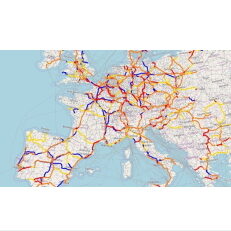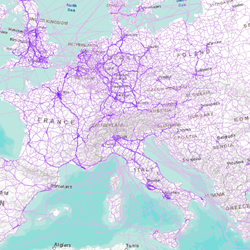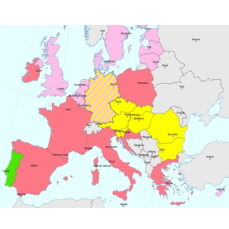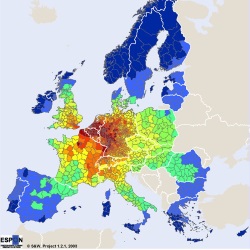- All
- African projects
- assessment
- assessment selected projects
- Assessment selected projects 2
- Assessment selected projects 3
- Assessment selected projects 4
- ASTRA
- Cost Benefit Analysis
- Electric mobility and ITS
- MOMOS
- planning
- planning selected projects
- planning selected projects 2
- planning selected projects 3
- planning selected projects 4
- planning selected projects 5
- projects
- Railways projects
- research
- research selected projects
- research selected projects 2
- research selected projects 3
- studies
- studies selected projects 1
- studies selected projects 2
- studies selected projects 3
- studies selected projects 4
- studies selected projects 5
- TRTingegneria
- TRUST
- urban mobility
- The Impact Assessment study, developed for the European Commission, aims to identify and assess the impacts of policy measures on facilitating the deployment of multimodal ITS services By enabling communication between vehicles, infrastructure and other road users, Cooperative Intelligent Transport Systems (C-ITS) can greatly improve safety and efficiency in road transport. Here is a look at some of the most recent developments in C-ITS and how quickly the technology could change the way we drive and interact with each other in traffic. The wide-scale deployment of Cooperative Intelligent Transport Systems could contribute to delivering several Commission’s objectives for transport, such as those on safety, reduced congestion, enhanced mobility and environmental performance. Together with Ricardo Energy&Environment, TRT supported the Directorate for Mobility and Transport of the European Commission in three different studies over a six year period. In 2020-2021 for the development of an Impact Assessment Support Study for the revision of the Intelligent Transport Systems Directive (2010/40/EU) to support the EC with evidence-based analysis. In 2017-2018 developing the legal framework required to support the widespread deployment of C-ITS services in Europe by 2019: a set of policy options and deployment scenarios were assessed with the European scale modelling tools ASTRA and TRUST for the analysis and comparison of the impacts in terms of economic, environmental and social indicators. In 2015 for the preparation of the Communication strategy and the Action plan for the deployment of C-ITS in Europe, providing the analysis of costs and potential benefits based on different scenarios. To support the analysis, the ASTRA and TRUST models are applied to provide quantitative indicators to evaluate the impacts of various policy options and deployment scenarios. For more information Final report of 2015 study Final report of 2017-2018 study
- Sustainable Transport Infrastructure Charging and Internalisation of Transport Externalities The objective of the study was to assess the extent to which the “user pays” and the “polluter pays” principles were implemented. This allowed the European Commission to take stock of the progress of Member States towards the goal of full internalisation of external and infrastructure costs of transport and to identify options for further internalisation. The scope of the study involved all external costs, all transport modes and, geographically, EU28 plus Norway, Switzerland, USA (2 States), Canada (2 provinces) and Japan. To realise the general objective and address the scope of the study information has been collected extensively about: infrastructure costs (i.e., investment, renewal and operating), transport-related charges, earmarking of fiscal revenues and compensations paid by the users. The analyses carried out in this study showed that the transport taxes and charges levied in the EU Member States are in general insufficient to fully internalise the external and infrastructure costs of transport. For most vehicle categories, only 15% to 25% of the external and infrastructure costs are covered by tax/charge revenues. The cost coverage ratio for passenger cars was found higher (about 50%), which was mainly because of the relatively high fuel and vehicle tax levels applied in (some of) the EU Member States for these vehicles. For inland waterways and maritime transport, much lower cost coverage ratios were found (i.e., 6% and 4%, respectively), reflecting the limited tax/charge burden levied on these modes in the EU. Even if one excludes fixed infrastructure costs from the analyses, the taxes and charges did not cover the external and variable infrastructure costs for most vehicle categories. High-speed trains are an exception, as for these trains the current taxes and charges did cover all external and variable infrastructure costs. This finding has been supported by the results of the analyses of the marginal social cost (MSC) coverage ratios. Despite the limitations of this analyses, it provides a first indication that there was a lack of charging in accordance with the MSC principle in the EU28. The revenues from transport taxes and charges in the EU28 were partly earmarked for expenditure for transport infrastructure. However, significant differences did exist between modes. For road transport, about 10% of the taxes/charges are earmarked, while for rail transport this is about 85%. For the other modes, only fragmented data on earmarking was identified, showing that (at least part of) the (air)port charges are earmarked to cover infrastructure expenditures. Although taxes and charges are efficient policy instruments to reduce the external costs of transport, the study recognize that other types of policy instruments and non-pricing policies (e.g., command-and-control measures and subsidies) may effectively complement tax and charge schemes, for example by providing EU-wide harmonised incentives to invest in certain reduction technologies. With regard to the activities of the study, TRT was responsible to (i) develop estimations of the external costs related to congestion for all transport modes (quantitatively for road), (ii) elaborate estimations of the infrastructure costs […]
- The impact of TEN-T completion on growth, jobs and the environment The objective of the study is to quantify the impact of the TEN-T core network implementation until 2030 – as well as the impact of each of the nine core network corridors separately – on European Union growth, jobs and the environment. The assessment is done with the support of two European scale modelling tools ASTRA and TRUST. ASTRA is a System Dynamics model used for assessing the wider economic impacts like indirect and induced changes in employment or value added and economic growth due to the TEN-T investments. TRUST is a transport network model allowing for the assignment of OD matrices at the NUTS3 level for passenger and freight demand which is used to provide the transport quantitative inputs to ASTRA. A set of major economic, environmental and transport indicators is provided for the assessment at EU level as well as at the level of Member States for the base year 2015 and the time horizons 2020, 2025 and 2030. The quantitative indicators are accompanied by qualitative arguments where required to elaborate on the quality of jobs created and the typology of jobs. For more information The impact of TEN-T completion on growth, jobs and the environment. Go to the publication
- Impact assessment accompanying the revision of Eurovignette Directive for Heavy Goods Vehicles charging The “Eurovignette” Directive provides a detailed legal framework for charging heavy goods vehicles (HGVs) for the use of certain roads. Following ex-post evaluations of the current legislative framework, the Commission intends to assess the potential impacts of options for a possible revision of the legislative act. The impact assessment study will help substantiate the specific problems linked to charging of vehicles and to design policy options in this field. TRT supports the quantitatve assessment of the impacts of the policy options through the use of European scale models ASTRA and TRUST.
- Support Study for the Impact Assessment Accompanying the Revision of the Eurovignette Directive (1999/62/EC) The charging of heavy goods vehicles (HGVs) for the use of road infrastructure in Europe is governed by Directive 1999/62/EC (the “Eurovignette” Directive). The Directive aimed to achieve step-wise harmonisation of vehicle taxes and establishment of fair mechanisms of infrastructure charging. The general objective of the proposed revision of Directive 1999/62/EC is to promote financially and environmentally sustainable and socially equitable (road) transport through wider application of the ‘user pays’ and ‘polluter pays’ principles (fair and efficient pricing). This study supported the DG MOVE experts in evaluating the impact of the new Directive analysing several interventions trough three different models: ASTRA (to estimate the impacts on the transport and economy systems), TRUST (to estimate the impacts on the traffic distribution), PRIMES-TREMOVE (to estimate the trend of the vehicle fleet). The model suite covers the entire transport system (e.g. transport activity represented at Member State level, by origin-destination and at link level, technologies and fuels at Member State level, air pollution emissions at Member State and link level and CO2 emissions at Member State level) and its macro-economic impacts. The modelling is complemented by a literature review and stakeholder consultation. Input from stakeholders is gathered via an online public consultation and a targeted consultation (mainly via interviews, with some written contributions) that gathers more detailed views and factual information on the considered policy options. For more information Support Study for the Impact Assessment Accompanying the Revision of the Eurovignette Directive (1999/62/EC), Final Report
- The ESPON project TRACC (TRansport ACCessibility at regional/local scale and patterns in Europe) The ESPON project TRACC (TRansport ACCessibility at regional/local scale and patterns in Europe) aimed at updating the results of previous studies, extending the range and the spatial resolution of accessibility indicators in response to the most recent policy questions. The TRACC conceptual framework is based on a systematic and comprehensive theoretical consideration of the major dimensions of accessibility, as well as of the most frequently used types of accessibility indicators and extensions of these. TRACC developed a systematic and consistent set of accessibility indicators, differentiated according to three spatial contexts (global, European, regional) and also between travel and freight. At European level, accessibility indicators for travel are further distinguished between traditional and newer ones. At regional level, moreover, a new set of indicators is included focusing on the accessibility to services of general interest, which are among the top priorities in the current policy agenda.






